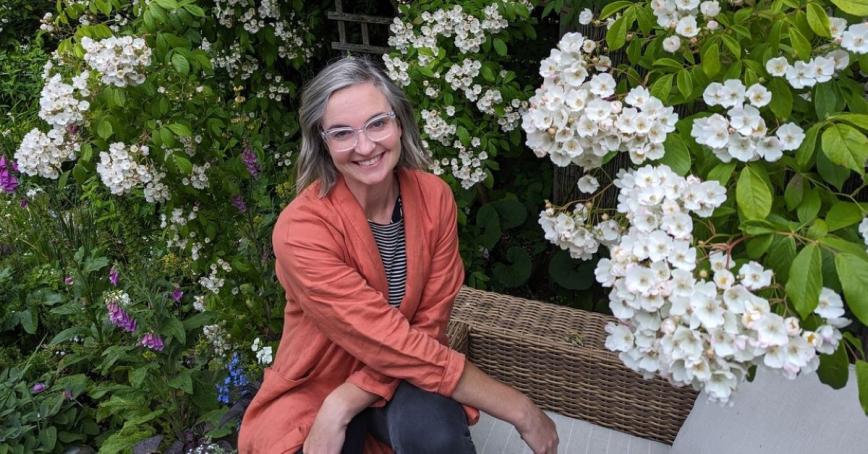RRU gardener Emma Lansdowne digs into history and colonialism

When you think of gardening, you may think of plants and seeds, soils, fertilizers and sunshine, and the colourful flowers or healthy vegetables produced by all the digging, tending and watering.
When Emma Lansdowne thinks of gardening — and she thinks about it a lot — she thinks of histories and cultures, plantations and slaves, colonialism and rebellion.
Lansdowne has worked as a gardener at Royal Roads University for 13 years, propagating plants and tending the border area around the croquet garden.
The Oak Bay, BC resident is also a PhD candidate in the Department of English and Cultural Studies at Ontario’s McMaster University and it’s the mulch of academics and botany that makes her interest bloom.
Lansdowne says her PhD research focuses on the “entanglement of gardens and imperial enterprise in the 18th and early 19th centuries.” Specifically, she’s looking at garden spaces and practices in “colonial contact zones,” which she defines as “spaces where disparate cultures meet and relations of power are negotiated.”
Noting that her work examines three regions — the South Pacific, North America’s Pacific Northwest and the Caribbean — she offers the example of sugarcane plantations in the Caribbean, where enslaved people not only worked to produce cash crops for the landowners, they also had to work to feed themselves by maintaining gardens often located outside the plantations.
“The enslaved people were required to have these provision grounds to grow their own food so they could then adequately perform slave labour,” she says. “Basically, they were in charge of feeding themselves to be better slaves.”
At the same time, she notes, they were able to cultivate the less than ideal grounds to maintain their own cultural and agricultural practices, growing the likes of yams and casavas.
“These are sites of resistance through cultivation within a deeply oppressive plantation structure,” she explains.
Asked how she moved from horticulture to history, Lansdowne says that as she spent hours and hours weeding and watering, she learned that she craved additional intellectual stimulation. And after completing an undergraduate degree in her early 20s, then a masters in her late 20s, “I found exploring the history of horticulture so stimulating that I just decided to continue on and do my PhD.
“My job as a gardener [at RRU] is very specific to the historical site where we work,” she adds. “All of the work we do is embedded in that history of the land. You can't separate the two...Everything that I do has to be consciously thought through so it's appropriate to the history and stories we are working to highlight and preserve.”
Although Royal Roads isn’t part of her research, she notes that it also is a complex colonial contact zone — a site used for millennia by the Xwsepsum (Esquimalt) and Lekwungen (Songhees) Peoples; settled by Europeans; then managed and manicured by the Dunsmuir family starting more than a century ago.
While the gardens are a lush and beautiful attraction today — and Lansdowne’s place of employment — they’re also an expression of land appropriation, she says: A Scottish castle dominates a campus built and maintained, at the beginning, by Chinese workers. A precise and colourful Italian garden, complete with statuary, sits next to it. A sprawling Japanese garden commissioned by white settlers bridges East and West. Lansdowne notes this rigid, formalistic design and cultivation are at odds with Indigenous Peoples’ approach to plant management.
But even as she says, “It’s important to think through gardening as a cultural inheritance. I’d love to see more tours at places like Royal Roads that talk about that,” she notes the steps RRU is taking to reintegrate traditional Indigenous plants on site. Indeed, a key part of the reimagining of a 5.26-acre former walled Edwardian kitchen garden into the Farm at RRU will be an Indigenous medicine garden.
And while she understands the complex relations of history and culture embedded in gardens all over the world, including at RRU, she also appreciates different peoples’ approaches to gardening whether for food or beauty.
“Gardens are so embedded in our everyday life — especially in Victoria because gardening is such a big pastime here — it’s something that we overlook because it’s so part of our everyday life. It’s part of our common experience.”
Dig into how you can help keep a good thing growing by supporting A Vision in Bloom.